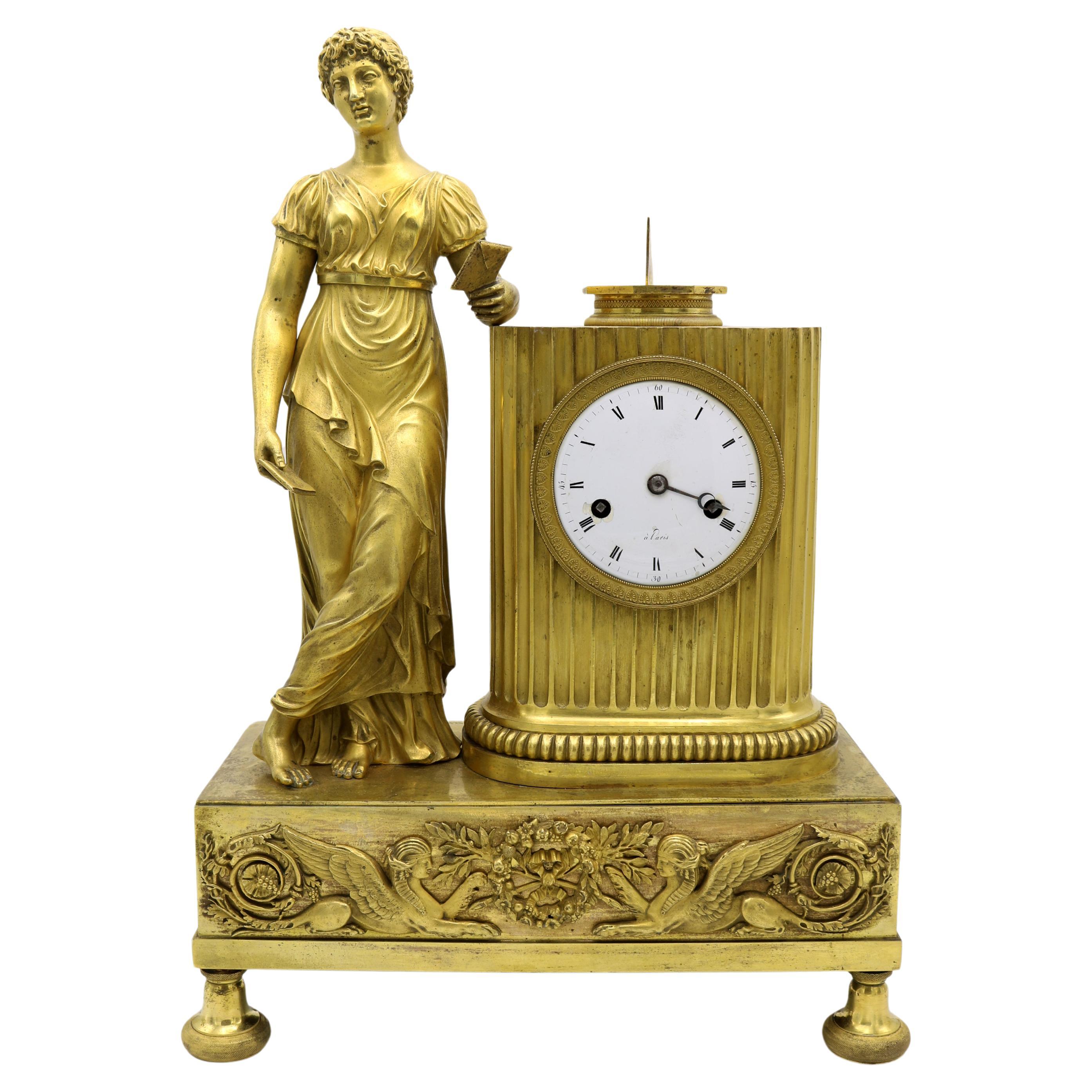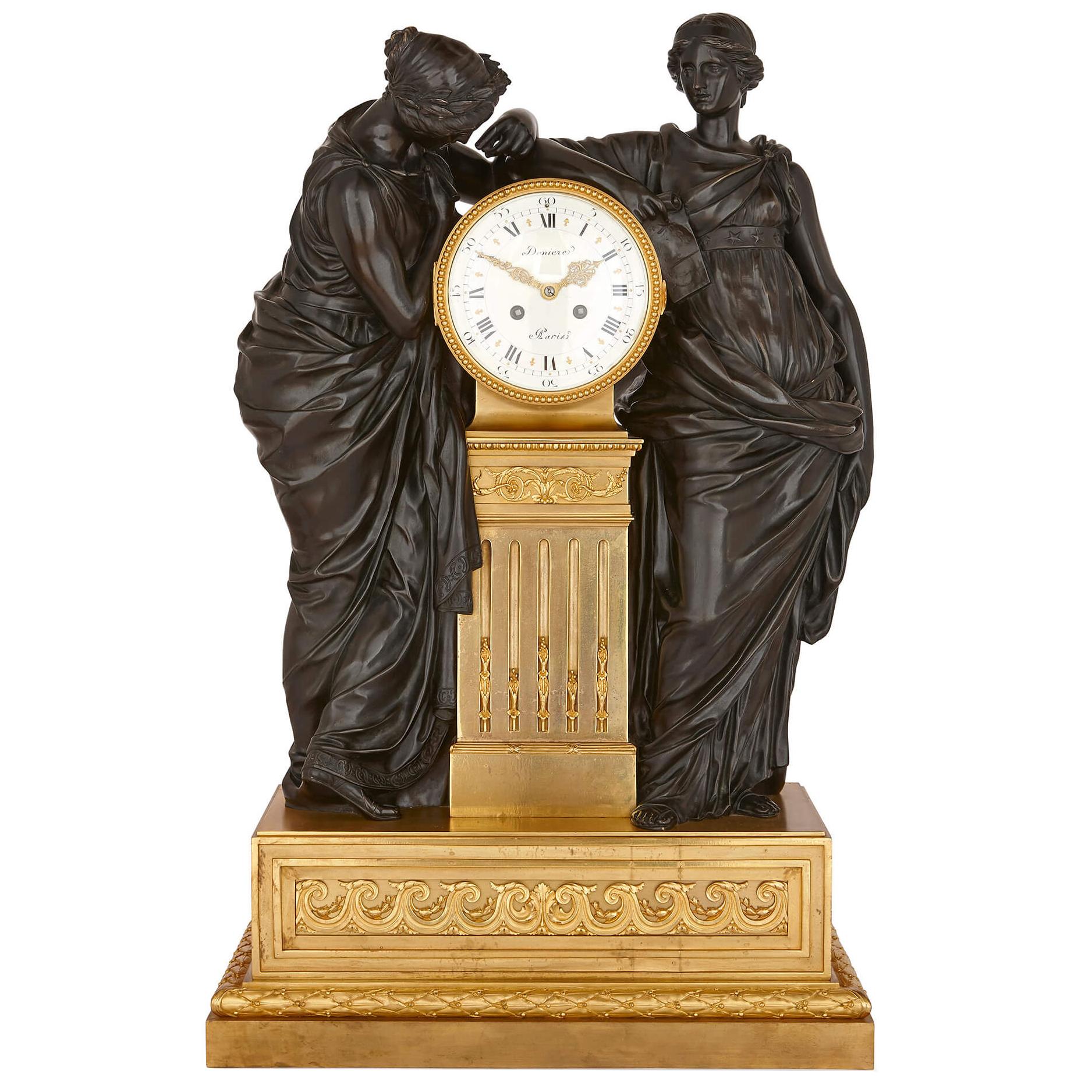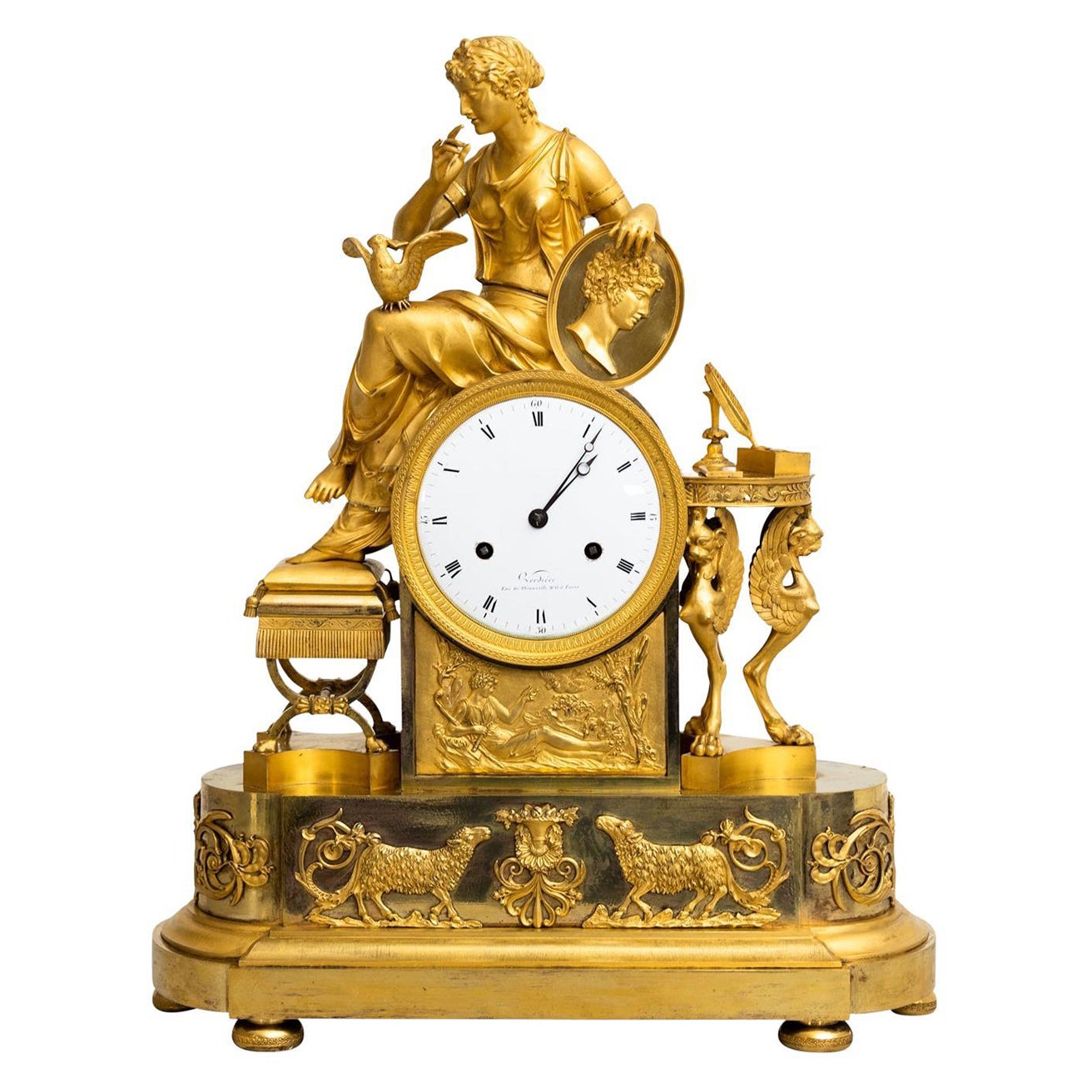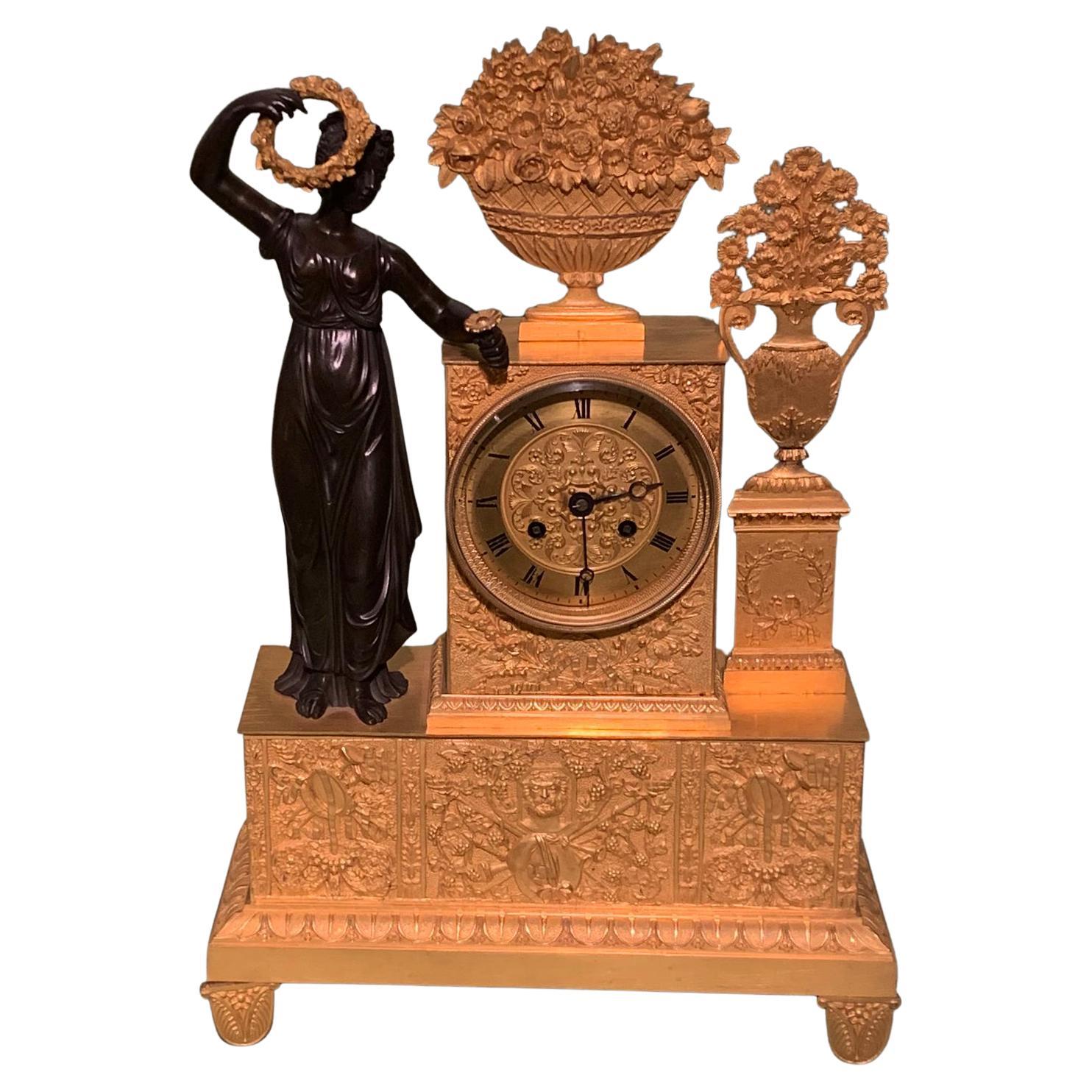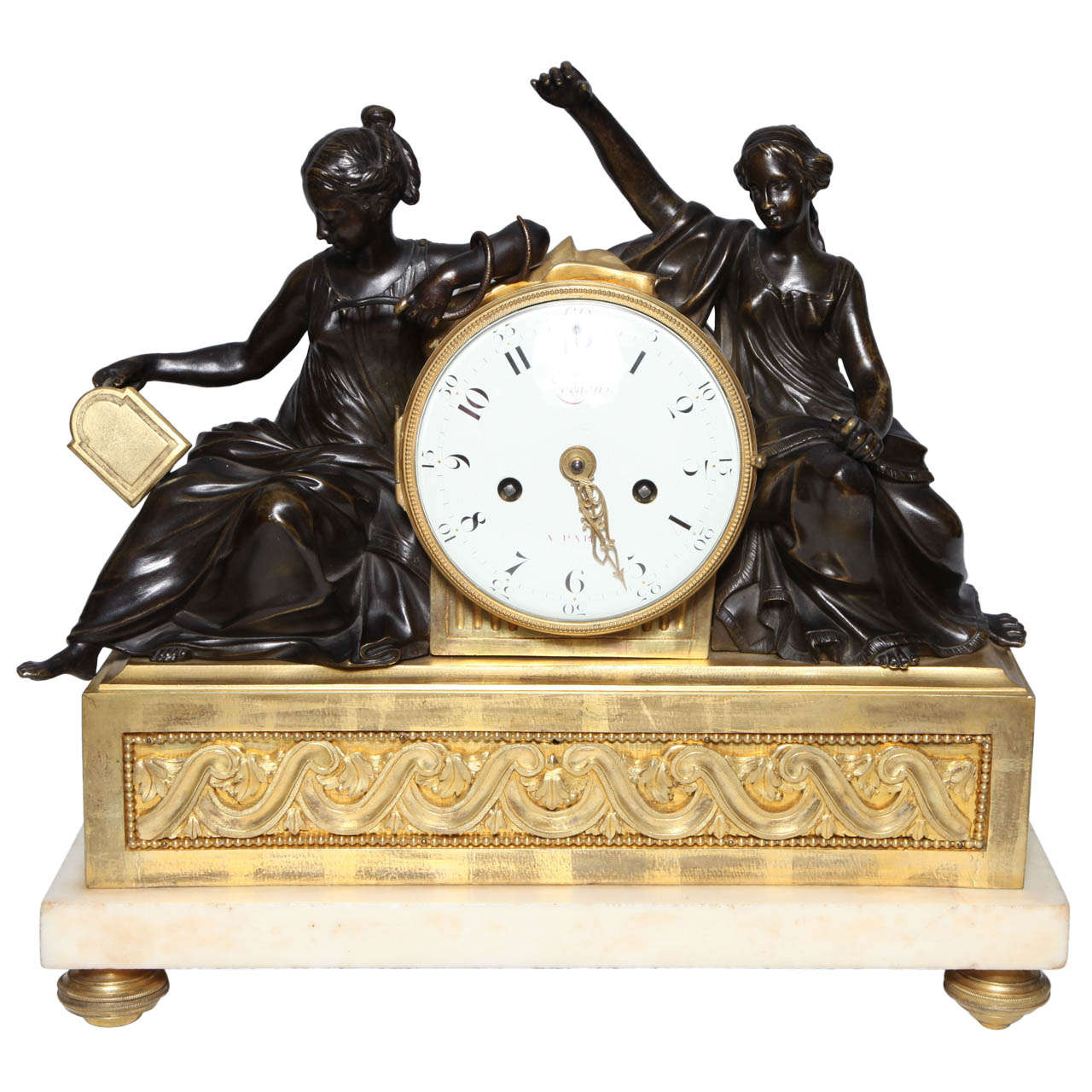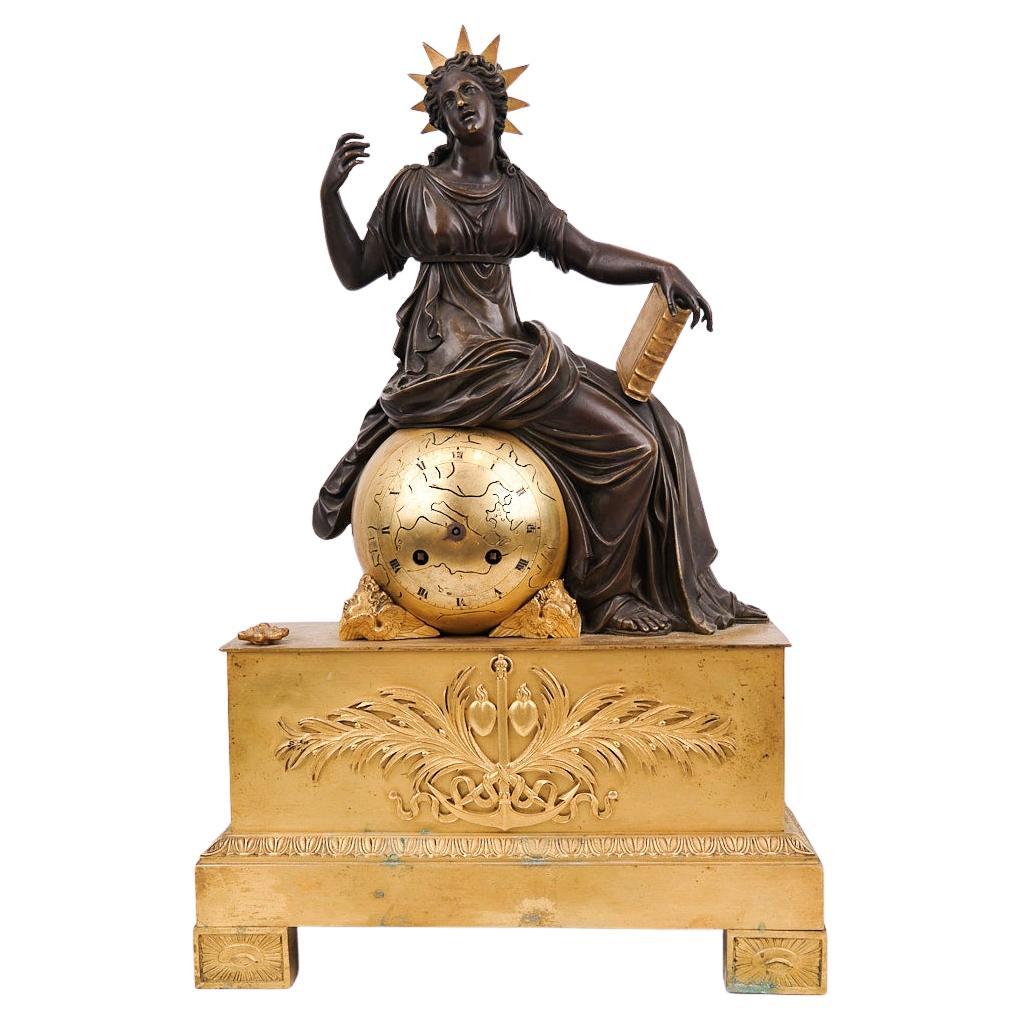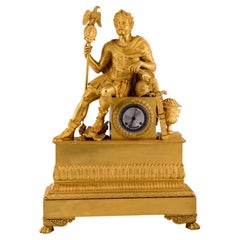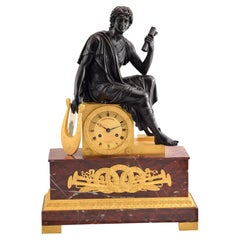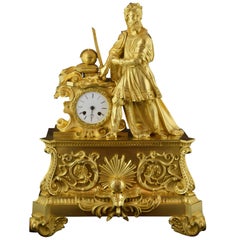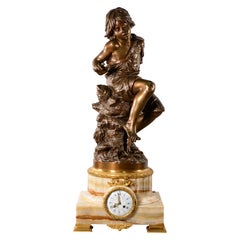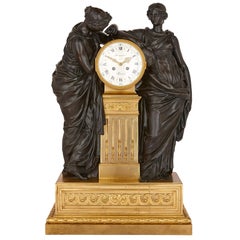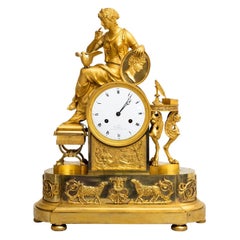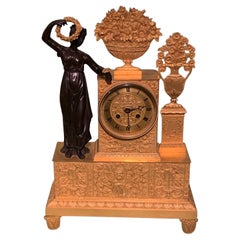Items Similar to Table clock with Muse and writers. Bronze, Paris movement. France, 19th century.
Want more images or videos?
Request additional images or videos from the seller
1 of 13
Table clock with Muse and writers. Bronze, Paris movement. France, 19th century.
$5,929.98
£4,456.95
€5,000
CA$8,216.08
A$8,930.56
CHF 4,780.67
MX$107,949.73
NOK 60,245.76
SEK 55,562.24
DKK 38,088.85
About the Item
Table clock with Muse and writers. Blued and gilded bronze, Paris movement. France, 19th century.
Perfectly working mechanism.
Table clock in blued and gilt bronze with Paris machinery, and white dial with gilt bronze centre (Roman numerals for the hours, lines for the minutes and Breguet-type hands). The rectangular pedestal stands on supports and has architectural decoration; the base of the clock, also rectangular, has vegetal crowns with scrolls enhancing cartouches (with names: Virgile, Tasse, Homere, Racine, Voltaire); the dial and machinery are housed in a gilt-bronze piece that resembles a bookcase, on which books, a crown of laurels and a musical instrument are displayed. A female figure in blued bronze, dressed in a tunic, holds this kithara, a plucked stringed instrument from ancient Greece, similar to the lyre (the difference being the sound box, so it could be a lyre of the present day).
The female figure would be a Muse: these classical divinities of Greek mythology inspired the arts; daughters of Zeus and Mnemosyne, companions of the god Apollo in his retinue, each is related to a branch of art and knowledge. They are linked to the lyre Calliope (muse of eloquence, beauty and epic poetry) and to the zither Erato (muse of lyrical-amorous poetry). As for the names mentioned, the first refers to Publius Virgil Maron (70 BC-19 BC), a Roman poet and author of the Aeneid, the Georgics, etc., who was also known for his role as a guide in Dante Alighieri's Divine Comedy. Torquato Tasso (1544-1595), Italian poet and author of The Liberated Jerusalem, Rinaldo, etc., is known as "Le Tasse" in French. Homer is the name given to the author of the Iliad and the Odyssey, the basis of Greco-Latin epic literature. Racine is the surname of, among others, the French playwright Jean Racine (1639-1699) and his son and poet Louis Racine (1692-1763). François-Marie Arouet (Paris, 1694-1778), better known as Voltaire, was a French writer, historian, philosopher and lawyer, with numerous literary and philosophical writings.
Curiously, we know of an Empire clock (in a private French collection) in the shape of a library with books, very similar to the present piece. It should be remembered that the high level of specialisation of French bronze craftsmen, which gave rise to high-quality works of art, meant that several pieces of the same model were created if the aristocracy and the upper classes liked it. For this reason, there is evidence of several clocks, with slight differences from the present one (particularly in the dial and the absence of blued bronze), preserved in private collections and dating from the early 19th century.
Weight: 12.7 kg. - Measurements: 40x15x57 cms
International Buyers – Please Note: for those articles that need Export Permits (those older than 100 years), the obtaining of the Permit will be processed without additional expenses (if you choose the seller sends it to you), but the period for the obtention of it may vary from 10 to 35 days.
- Dimensions:Height: 22.45 in (57 cm)Width: 15.75 in (40 cm)Depth: 5.91 in (15 cm)
- Style:Neoclassical Revival (Of the Period)
- Materials and Techniques:
- Place of Origin:
- Period:
- Date of Manufacture:19th century
- Condition:Wear consistent with age and use. Minor losses. Minor fading. Machinery in working condition (in place of origin).
- Seller Location:Madrid, ES
- Reference Number:Seller: zf10691stDibs: LU2951338692502
About the Seller
4.9
Vetted Professional Seller
Every seller passes strict standards for authenticity and reliability
Established in 1985
1stDibs seller since 2017
357 sales on 1stDibs
Typical response time: Several days
- ShippingRetrieving quote...Shipping from: MADRID, Spain
- Return Policy
More From This Seller
View AllTable clock, Aníbal Barca. Ormolu bronze, metal. France, 19th century.
Located in Madrid, ES
Table clock, Aníbal Barca. Ormolu bronze, metal. France, 19th century.
Table clock with Paris machinery and a case made of mercury-gilded bronze. in mercury-gilded bronze, with a rectangular base on four rectangular base on four legs (the front ones decorated with scrolls and decorated with scrolls and ending in claws), decorated with a series of mouldings in relief with vegetal and architectural elements. vegetal and architectural elements in relief. The dial The dial (metal with Roman numerals for the hours) is set within a square shape, on which sits the male figure that decorates the piece. A bearded man, dressed in armour (a muscular loriga or cuirass) and a cape fixed over one shoulder with a fibula, resting his left arm on the helmet holding a rolled-up document, and with his left hand document, and with his left hand he holds a Roman standard (another Roman standard (another is broken, under his foot). Note, to the right and next to a sword, a vase full of rings.
vase full of rings.
Hannibal Barca (247-183 BC) was a Carthaginian general and statesman who was well known for his Carthaginian general and statesman, well known for his the ancient Roman Empire. No He was often depicted as counting the rings of fallen Roman knights in
the fallen Roman knights at the battle of Cannas (216 BC). , as can be seen in the sculpture by
sculpture by Sébastien Slodtz (made in 1704, Louvre Museum, Paris), where he also carries a Roman banner. Roman standard. With these two elements (vase with rings and with rings and a banner) is also shown on a table clock...
Category
Antique 19th Century European Neoclassical Revival Mantel Clocks
Materials
Bronze, Other
Table Clock, Apollo, Bronze, Marble, Model of Lenoir-Ravrio, Louis-Stanislas
Located in Madrid, ES
Table clock, Apollo. Bronze, marble. Model of Lenoir-Ravrio, Louis-Stanislas(1783-1846). Paris, around 1820.
Table clock composed of a staggered rectangular base made of red veined...
Category
Antique Early 19th Century French Neoclassical Mantel Clocks
Materials
Bronze, Other
Table Clock, Ormolu, 19th Century
Located in Madrid, ES
Table clock made of gilded bronze with a powerful base, enhanced with legs decorated with vegetal and architectural motifs of classicist inspiration and a series of details on the fr...
Category
Antique 19th Century European Neoclassical Mantel Clocks
Materials
Bronze
Clock with sculpture. Bronze, stone. Coupier Fila and Provart, Paris, France.
Located in Madrid, ES
Clock with sculpture. Bronze, stone. Coupier Fila and Provart, Paris, France, late 19th century.
Bronze sculpture depicting a boy sitting on a rock formation, raising one bare foot ...
Category
Antique 19th Century French Other Table Clocks and Desk Clocks
Materials
Stone, Bronze, Other
Louis XVI style mantel clock. Biscuit, metal, glass. Crosnier, Paris, France
Located in Madrid, ES
Louis XVI style mantel clock. Biscuit, metal, glass. Crosnier, Paris, France, circa 1900.
It has defects.
A table clock made of bisque porcelain with metal fittings, featuring a wh...
Category
Early 20th Century French Other Table Clocks and Desk Clocks
Materials
Other, Metal
Wall clock. Gilt bronze. France, 19th century.
Located in Madrid, ES
Wall clock. Gilt bronze. France, 19th century.
Gilt bronze wall clock of the type known as a "cartel" due to its shape, featuring Parisian movement and a white dial with Roman numer...
Category
Antique 19th Century French Neoclassical Revival Wall Clocks
Materials
Bronze, Other
You May Also Like
French Empire Gilt Bronze Mantle Clock , France 1810
Located in New York, NY
Resting on four very elegant feet the clock features a rectangular base decorated on three sides with classical motifs. The face features a pair of Sphinx flanking a wreath with lau...
Category
Antique 1810s French Empire Mantel Clocks
Materials
Bronze
Antique French Bronze and Ormolu Mantel Clock
By Maison Deniere
Located in London, GB
This large mantel clock is an excellent piece of refined neoclassical design by the acclaimed Deniere et Fils firm. Deniere was one of the leading ...
Category
Antique 19th Century French Neoclassical Mantel Clocks
Materials
Ormolu, Bronze
19th Century Gold French Empire Gilded Bronze Table Clock, Antique Pendule
Located in West Palm Beach, FL
A gold, antique French table clock, pendulum made of hand crafted fire-gilded bronze, in good condition. The circular enamel dial of the Pa...
Category
Antique Early 19th Century French Empire Mantel Clocks
Materials
Metal, Bronze
Early 19th Century French Bronze and Ormolu Eight Day Striking Clock
Located in London, GB
An early 19th century French eight day silk-suspension, striking clock, contained in ormolu case mounted with vases and urns of flowers with well-cast b...
Category
Antique Early 19th Century French Neoclassical Revival Mantel Clocks
Materials
Bronze, Ormolu
Louis XVI Period Antique French, Patinated and Dore Bronze Mounted Figural Clock
Located in New York, NY
A Very Fine Unusually Large Louis XVI Period antique French, Patinated and Dore bronze Mounted Figural Clock. A pair of maidens are mounted on either side of the clock, which rests o...
Category
Antique 18th Century and Earlier French Louis XVI Clocks
Materials
Bronze
French Mantel Clock In Bronze Decorated With Female Figure In Empire Style
Located in Lejre, DK
French bronze mantel clock from the 1820s. Empire style with female figure, radiant crown and book. Elegant and well-preserved clock from Paris.
— Origin: France, Paris
— Period: 18...
Category
Antique 1820s French Mid-Century Modern Table Clocks and Desk Clocks
Materials
Bronze
More Ways To Browse
Blue Bronze
Used String Instruments
Antique Clock Movement Antique Clocks
Antique String Instrument
Antique Clock Collection
The Iliad
French Clock Movement
Blue Table Clocks
Antique French Clock Movement
Torquato Tasso
Used Zithers
Antique Zithers
Ormolu Garniture Set
Bronze Art Deco Clock
Tortoiseshell Boulle
Antique Clock Stamps
Arch Clock
Champleve French Clocks
